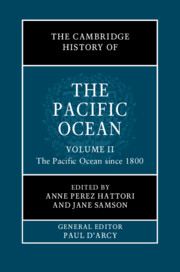Book contents
- The Cambridge History of the Pacific Ocean
- The Cambridge History of the Pacific Ocean
- The Cambridge History of the Pacific Ocean
- Copyright page
- Contents
- Figures
- Tables
- Contributors to Volume II
- Frontispiece
- General Editor’s Introduction
- Preface to Volume II
- Part VII Rethinking the Pacific
- Part VIII Approaches, Sources, and Subaltern Histories of the Modern Pacific
- Part IX Culture Contact and the Impact of Pre-colonial European Influences
- Part X The Colonial Era in the Pacific
- Part XI The Pacific Century?
- 54 The USA and the Pacific since 1800
- 55 World War II and the Pacific
- 56 The Nuclear Pacific
- 57 Shrinking the Pacific since 1945
- 58 China and the Pacific since 1949
- 59 Pacific Island Nations since Independence
- Part XII Pacific Futures
- References to Volume II
- Index
57 - Shrinking the Pacific since 1945
Containerships, Jets, and Internet
from Part XI - The Pacific Century?
Published online by Cambridge University Press: 11 November 2022
- The Cambridge History of the Pacific Ocean
- The Cambridge History of the Pacific Ocean
- The Cambridge History of the Pacific Ocean
- Copyright page
- Contents
- Figures
- Tables
- Contributors to Volume II
- Frontispiece
- General Editor’s Introduction
- Preface to Volume II
- Part VII Rethinking the Pacific
- Part VIII Approaches, Sources, and Subaltern Histories of the Modern Pacific
- Part IX Culture Contact and the Impact of Pre-colonial European Influences
- Part X The Colonial Era in the Pacific
- Part XI The Pacific Century?
- 54 The USA and the Pacific since 1800
- 55 World War II and the Pacific
- 56 The Nuclear Pacific
- 57 Shrinking the Pacific since 1945
- 58 China and the Pacific since 1949
- 59 Pacific Island Nations since Independence
- Part XII Pacific Futures
- References to Volume II
- Index
Summary
Over recent decades the global economy has tilted from a trans-Atlantic Euro-American economy towards an Asia-Pacific one, a shift encapsulated by the term Pacific Century. Nine Group of Twenty (G20) nations – Australia, Canada China, Indonesia, Japan, Mexico, Russia, South Korea, and the USA – are contiguous with the Pacific Rim. Yet despite common use of the adjectives Pacific, trans-Pacific, and Asia-Pacific, the boundaries and structure of this notional economy are still vague. This chapter maps the articulation of a Pacific economy since 1945 through geologistics as a two-stage process, first reformation and densification of pre-war networks until the end of the 1960s, then transformation through the new technologies of container shipping, jet aircraft, and the Internet. It becomes apparent that this transformation had had much greater impact upon adjacent continental economies than upon the vast coastal and almost hollow archipelagic region that may be denoted as Pacifica.
- Type
- Chapter
- Information
- The Cambridge History of the Pacific Ocean , pp. 634 - 663Publisher: Cambridge University PressPrint publication year: 2023
- 1
- Cited by

